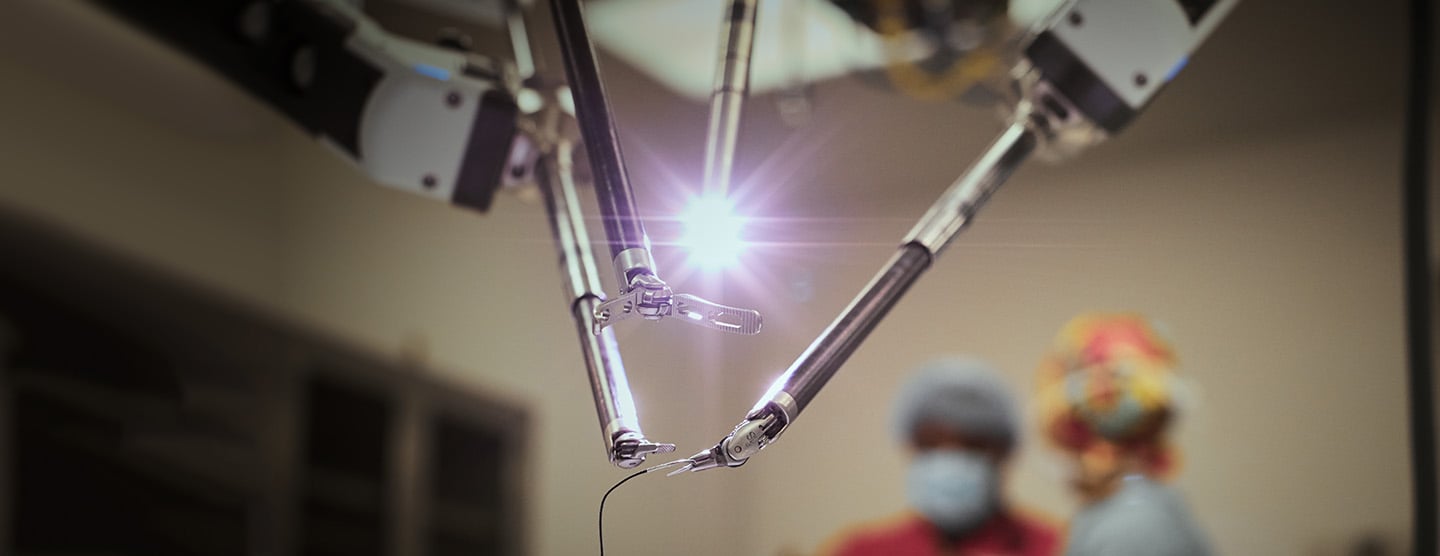Mitral Valve Disorders

Overview
One of the heart's four valves, the mitral valve is located between the heart's upper-left chamber, called the left atrium, and the heart's lower-left chamber, called the left ventricle.
Valves control blood flow through the heart. The mitral valve controls blood flow from the left atrium into the left ventricle. When the heart contracts, the mitral valve closes to prevent blood from backing up into the lungs. If the valve becomes diseased or damaged, it may be surgically repaired or replaced to restore function.
If left untreated, mitral valve disease may lead to more serious problems, such as heart dilation, in which the heart's walls become stretched and weakened. As a result, heart rhythm problems may occur, including atrial fibrillation.
Types of Mitral Valve Disorders
The two most common conditions that require mitral valve repair include:
- Mitral Valve Prolapse Myxomatous degeneration of the valve, also known as "floppy valve" or mitral valve prolapse, is the most common condition that requires mitral valve repair. It occurs when the mitral valve leaflets become floppy or loose and the valve does not open and close properly. In most cases, it does not cause symptoms and therefore treatment is not required.
However, in more severe cases, the condition may cause mitral valve regurgitation, in which the blood leaks backwards into the lungs. This may result in heart dilation, in which the heart's walls become stretched and weakened. As a result, heart rhythm problems may occur, including atrial fibrillation. Almost all of leaky valves caused by myxomatous degeneration can be successfully repaired with surgery. - Mitral Valve Stenosis Mitral valve stenosis is a narrowing of the opening of the mitral valve, which can prevent the valve from opening and closing normally, reducing the amount of blood flow through the heart. Over time, stenosis can cause high blood pressure in the left atrium and the lungs, which can lead to breathing difficulties.
Other conditions that may require mitral valve repair include:
- Endocarditis This is an infection affecting the heart valves or the inner surface, called the endocardium, of the heart. Endocarditis typically occurs when bacteria or other germs in the mouth, intestinal tract or urinary tract travel to the heart via the bloodstream and lodge in the heart. These bacteria usually don't cause problems in normal hearts, but hearts with defects or those that have been repaired are vulnerable to infection. Once infection occurs, the bacteria continue to grow and may seriously damage the heart.
- Heart Failure Heart failure develops when the heart doesn't function properly. The names "heart failure" and "congestive heart failure" (CHF) often confuse people since the heart hasn't actually "failed" or stopped. Heart failure is a medical term that describes the condition in which one or more chambers of the heart "fail" to keep up with the volume of blood flowing through them. Heart failure can be brought on by a variety of underlying diseases and health problems.
Patients with end-stage heart failure who have severe regurgitation — in which the blood leaks backwards into the lungs — may require mitral valve repair. However, many of these patients will eventually need a heart transplant.
Our Approach to Mitral Valve Disorders
At UCSF, patients with mitral valve disorders are treated by a team of specialists in heart valve problems, including interventional cardiologists and cardiothoracic surgeons. We offer the full range of therapy options, including minimally invasive approaches to repairing or replacing the valve. Compared with traditional open heart surgery, these procedures have many benefits for patients, including faster recovery, less postoperative pain and minimal scarring.
Research shows that when faulty valves are repaired early on, before they lead to heart damage, patients have much better immediate and long-term results. Our surgeons have had tremendous success in repairing early-stage mitral valve disorders. Research has also shown many advantages to surgically repairing – rather than replacing – a mitral valve. In certain cases, however, the valve may be so seriously damaged that replacement is recommended.
Awards & recognition
-

Among the top hospitals in the nation
-

One of the nation's best in cardiology and heart & vascular surgery
Signs & symptoms
Surgical repair of a malfunctioning mitral valve is recommended when it causes symptoms such as shortness of breath, fatigue, chest pains, dizziness, swelling of the ankles or legs, cough or heart palpitations. It may also be recommended when the damaged or diseased mitral valve causes the heart muscle to weaken.
Diagnosis
The diagnosis of mitral valve disease is confirmed with echocardiography. This is a safe, painless test that uses sound waves (ultrasound) to examine the heart's structure and motion. This test provides information about the heart's pumping ability, blood flow activity, valve function, size and pressure.
UCSF is an international leader in echocardiography and has been at the forefront of developing new techniques and equipment in this field. UCSF cardiac surgeons not only use echocardiography before surgery to diagnose mitral valve disease and plan the procedure, but also during repair.
In many cases, the echocardiography tells surgeons all they need to know to perform the surgery, so that cardiac catheterization — an invasive procedure performed to obtain detailed information about the heart — is not necessary. Cardiac catheterization uses catheters, which are thin, flexible tubes inserted through tiny incisions in the groin or neck and threaded through blood vessels to the heart.
Treatments
If the mitral valve becomes diseased or damaged, it may be surgically repaired to restore function. Mitral valves also may be replaced with an artificial or natural valve. However, research has shown that there are many advantages of surgically repairing, rather than replacing, a mitral valve. In certain cases, however, the valve may be so seriously damaged that valve replacement is recommended.
Your surgeon will discuss both treatment options with you. The decision regarding whether to have valve repair or replacement depends on a number of factors, including your age, overall health, cause of valve damage and expected benefits of surgery.
Surgical Repair
Mitral valve repair is an open heart procedure performed by a cardiothoracic surgeon, a doctor who specializes in heart and lung conditions.
The two most common surgical mitral valve repairs include:
- Ring Annuloplasty The annulus, or ring-like part of the valve, is tightened by placing a flexible ring of metal, cloth or tissue around the damaged valve.
- Valve Repair The damaged leaflets, chordae, and/or papillary muscles of the valve are surgically reconstructed.
Surgically repairing, rather than replacing a valve spares the surrounding structures that attach the valve to the heart, which are important for maintaining the heart's shape and function. Studies have shown that removing those structures during valve replacement may not affect heart function immediately, but 10 years after surgery, the heart is much weaker.
In addition, inserting artificial valves into the heart may cause infections or complications, such as blood clotting. Patients who have valve repair, rather than valve replacement, do not need to take the blood thinner Coumadin, and also have a quicker recovery time, due in part to less invasive surgical techniques.
We can perform certain mitral valve repairs using minimally invasive techniques, such as robotic surgery, reducing recovery time and the risk of surgical complications.
Early Mitral Valve Repair
UCSF heart surgeons also specialize in early mitral valve repair before the heart is severely damaged by the faulty valve. Recent research suggests that earlier surgical intervention, particularly if repair is possible, may prevent irreversible damage to the heart. Evidence shows that patients who have their valve repaired early on have greatly improved short- and long-term results. And because the heart's tissue is still healthy at the time of repair, recovery time is much quicker.
The push to make mitral valve repairs early is only one of several important changes that have swept the field in recent decades. One of the most important procedural differences between today and years past is that now the existing valve is often repaired, rather than replaced with an artificial or human valve.
UCSF Health medical specialists have reviewed this information. It is for educational purposes only and is not intended to replace the advice of your doctor or other health care provider. We encourage you to discuss any questions or concerns you may have with your provider.
Where to get care (3)
Faster recovery, fewer risks with robot-assisted surgery
At UCSF, we perform complex, delicate procedures with a minimally invasive approach. Our surgeons use the Da Vinci Xi system, the most sophisticated technology available.










